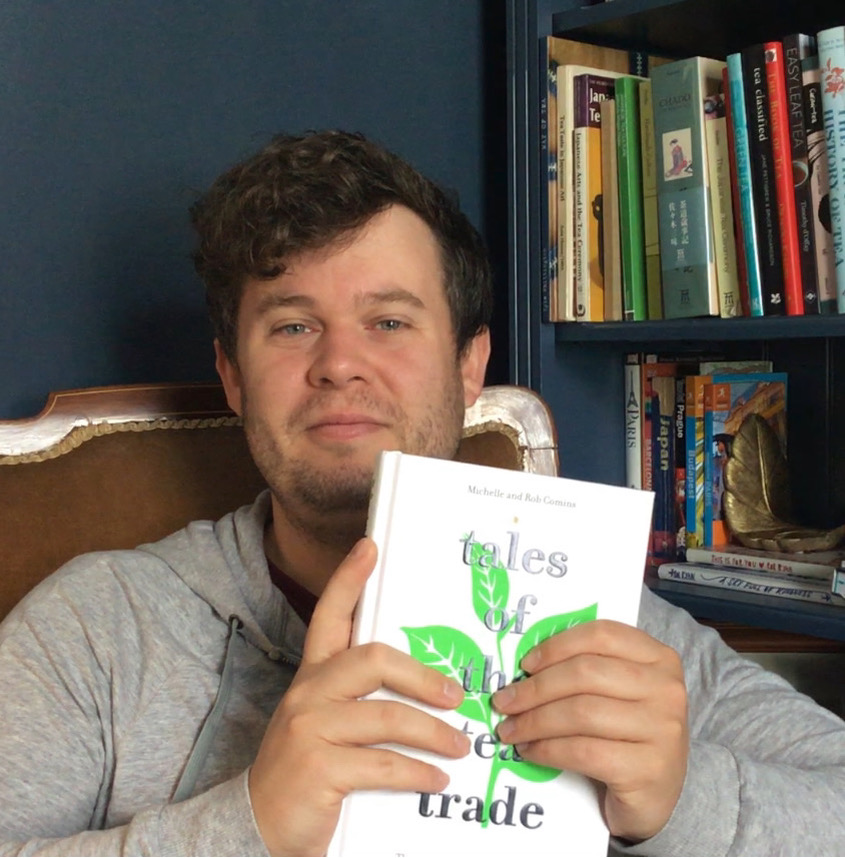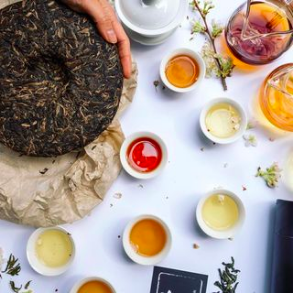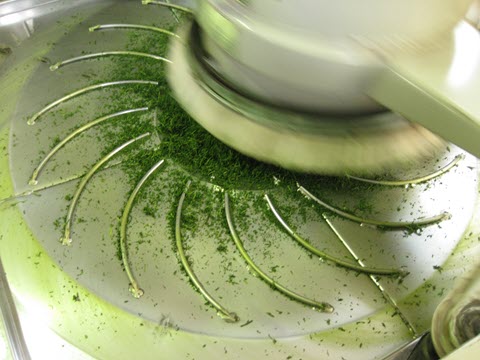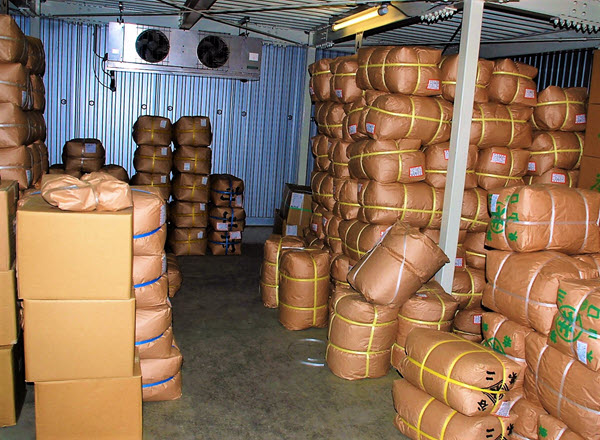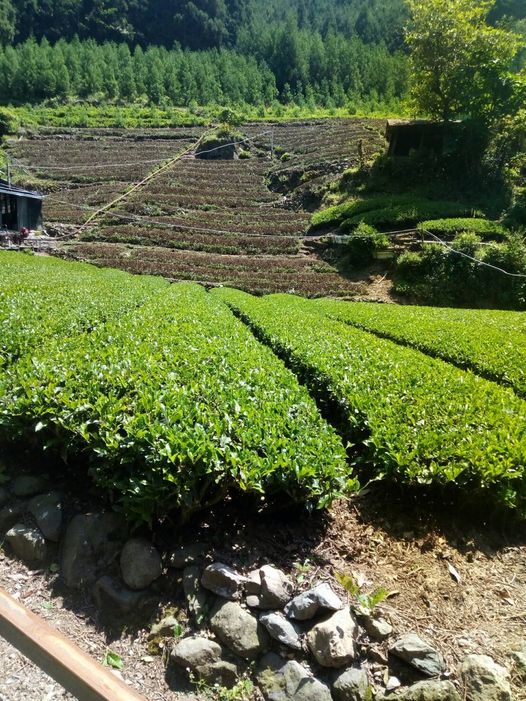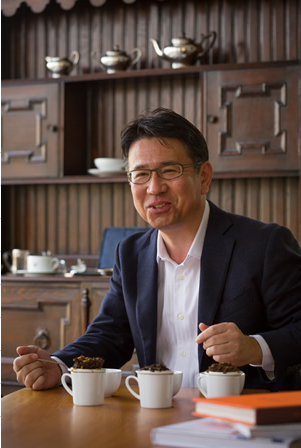A money-losing federation of small grower co-operatives in Tamil Nadu, the largest of its kind in India with a history dating to 1965, languished for decades before Supriya Sahu emerged as a leader with a singular message: produce tea that builds the lives of farmers and a better future. “That’s our ambition, to transform an organization that was a sleeping giant into one that can show the world that a small growers’ organization can be the best among the best,” she says.

Awakening a Sleeping Giant
Supriya Sahu arrived in the Nilgiris in 2019 to head INDCOSERVE, a cooperative of tea farmers started by the government of Tamil Nadu. In less than two years, she has turned this 55-year-old loss-making cooperative into a profitable one. INDCOSERVE’s 30,000 small farmers and 16 tea factories produce 14 million kilos per year, with a newly launched retail range. We talk to Sahu about how she has pulled this ambitious and audacious plan that can well serve as a blueprint for small growers across the country.
Aravinda Anantharaman: This is your second deputation in the Nilgiris. When was the first one? And how did the second one come about? What did you do between these two deputations to the Nilgiris?
Spuriya Sahu: The first one was 20 years back, between 1999-2002, when I was posted as the Collector of the district. I worked for the government of India for almost 10 years. I worked mostly in the ministry of information and broadcasting where I looked after the policy aspects of broadcasting, basically the licensing of the television channels and community radio and content regulation on television channels, et cetera. Those were my earlier assignments. After that, I was posted as Director General, Doordarshan. After competing 10 years, it was time to do something at the grassroots. Tamil Nadu government was kind enough to post me here because there was an opportunity to work with the farmers. So having worked at the policy level for a very long time, I think it was very important, interesting to touch base with the ground reality to see what’s happening in the field.
Aravinda: When you took over managing INDCOSERVE, where was it at? What did you inherit?
Supriya: Basically it’s like a sleeping giant. That’s what I’m telling my team all the time. That it is like a sleeping giant and we are awakening it slowly. It has a huge potential and it could be a game changer in the tea industry. I am saying this because of many reasons.
One, I think our greatest strength is that we are a cooperative. It is a democratically elected institution. INDCOSERVE is not headed by officers, but by farmers themselves. How many organisations can boast of that? The chairman of INDCOSERVE is a small farmer himself. We have 16 factories. Each factory has a board and the board is headed by a small farmer. How does it help? It helps because then they have a direct role to play in whatever they do. Almost all these small growers have been with us for more than 20 years, 30 years; we are doing enrolment of new members, which is a continuous process.
If profitable, as a very large player in the sector, we can be a game changer for the tea industry. Because we can set standards and benchmark us, which we were not doing earlier. With all due respect to my colleagues before me, I think most of them were holding the position as an additional charge. They were managing it remotely, sitting at Chennai or elsewhere. You did not have such a senior officer managing it from the headquarters. And that makes a lot of difference because you are there 24 by 7 to handle the affairs of the institution.
Aravinda: How is INDCOSERVE set up?
Supriya: It’s a cooperative federation. There are 16 factories affiliated to us. INDCOSERVE was set up by the government in 1965. Then the first factory was inaugurated at Kundah. Over a period of time, several factories have come up. We have about 30,000 members, 30,000 small tea growers who are members. That makes us one of the largest tea co-operative federations in Asia. And of course the largest cooperative federation in India. Because you have the bought leaf factories, you have STGs.
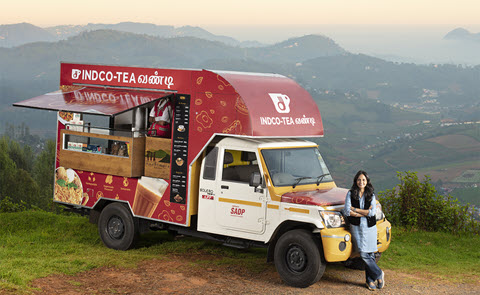
If you look at the North Indian tea sector, it’s mostly estates. There are some small growers also, but they are not affiliated in a cooperative structure. Whereas in South India, it is mostly the bought leaf structure, but like a federation people coming together, working for themselves, this may be the only one in the country.
Aravinda: The cooperative model is challenging. What were INDCOSERVE’s challenges?
Supriya: We had several brainstorming sessions with our small growers. I also started something called open house where every Monday, any small grower can drop in here.I wrote about 30,000 letters to small growers, saying that I’m here to serve you. Here is the number to my office, my office address, my email. Please tell me what shall we do. That letter was also very emotional because I also wrote to them as the previous district collector who served them 20 years back. I have that connection with the people of this district.
We had several rounds of discussions in the field, and then we identified several challenges, which we have documented. The most important challenge was that INDCOSERVE could never emphasise on quality of our teas. We were not even known. Nobody knew about INDCOSERVE as a brand, as an entity.
Now maintaining quality of tea leaves is a biggest challenge because we are not like a big estate where people can just ask their labourers to pick two leaves and one bud. Here, farmers just pick the leaves and bring it to us. We did not have leaf supervision standards in the factories. That was the biggest challenge we identified. But then, how do you make sure that 30,000 farmers understand how important is the quality of leaves? How do we make them understand that the quality of the leaf has a repercussion on the quality of the tea that we make.
We did several demonstrations telling our farmers that when you bring this kind of a leaf, this is the tea you produce. We launched something called as a mission quality, which was at three levels: what we will do at the INDCOSERVE level, the factory level and the grower level.
We started from the grower level. We have about 200 leaf supervisors. They are the people from the community, about 20-30 of them with each factory. Their job is to collect the leaf from the growers bring it to a collection centre, or the grower brings it to the collection centre. The transportation vehicle brings it to the factory. We trained all our leaf supervisors. That was the most critical because whenever a farmer brought the leaves, they were able to demonstrate, that you give this leaf, this is what we will produce. I would say about 55% to 60% of the leaf quality has improved dramatically, thanks to this kind of an interaction which we did at the grower level.
Then we also had several hours of meetings where we trained small grower representatives. One interesting thing in the Nilgiris, here the Badaga community, who cultivate land, who are the main supplier of tea, is a very cohesive, a very tight knit community. In fact, the entire village is like a family. If they see a value, they will tell everybody in their community to follow it. It’s a discipline, it’s coming together, it’s a team work. So that really helped us.
At the factory level, they did not have any standard operating procedures at all, no SOPs were in place. We consulted private bought leaf factories. We consulted some private estates like Chamraj. We learned, we went to them, we took our teams to see how a private sector company operates. And it was a huge learning. We took our MDs, we took our Chairman … it was an eye opener. Because they saw that the factories were so clean, so hygienic, so well maintained; packaging was so good, marketing was fantastic. They felt we can do it. So we introduced SOPs, we introduced monitoring of the liquor, we appointed quality officers. We appointed a Chief Quality Officer at the INDCOSERVE level. And at the factory level, we appointed five quality officers monitoring the quality of teas across the factories. They’re all experienced people who have worked in the private sector for a very long time.
At INDCOSERVE level, we have introduced a weekly and a weekly internal certificate mechanism. We give an internal certificate with quality grades. There is a healthy competition to get the A quality, because we have told them that those who will get the maximum number of these certificates will be eligible for an annual award. We are introducing an award system to incentivise the factories, as well as the MDs.
These were the major things that we introduced as far as the quality, but then I can go on talking about it because there are many things that we did, in marketing, in building a brand and things like that.
Aravinda: Just to go back a bit, when you wrote those 30,000 letters, did you get responses from the people?
Supriya: Many people did. About 35 or 37 called me to say, you have to do this, our factory is not operating at the optimum capacity. Their feedback was so good, so precise. They knew what was happening in the machinery. Many people also said that the tea maker was not good, or that the staff were not paying attention.
They also had an issue with non settlement of their dues. In fact, that was another major reform, We were not announcing the base price of the green leaf, which means if I am a farmer, I won’t know much money I will be paid upfront. We started announcing the price on first of every month. The farmer knew if I supply my leaf, I will get this. He or she was able to compare it with the private factory.
We were paying much less than the price determined by the tea board of India. That was not instilling the confidence. I think most of the grievances were attached to this, that they were not getting the base price determined by the Board.
Many of my factories were making a loss. We took a calculated risk in ensuring that we give the price determined by the board, to be on the right side of the law, and because it’s their right. I’m still happy to say in the last one year, except maybe for two months, we have been able to pay either the tea board rate or above.
We got more leaf. We’ve been able to operate our factories at an optimum level. It built the confidence of growers in the organization.

Aravinda: Was there infrastructure upgrade to the factories?
Supriya: Most of our factories are 30 to 40 years old, some as old as 50. No upgrade had happened and only some machineries had been upgraded. There has not been an integrated upgrade of the machinery. We have got an upgradation plan as well as funding support from the government of Tamil Nadu and NABARD, under a scheme called as the Rural Infrastructure Development Fund. We have got about INRs 18.5 crore. We are renovating five factories which in the next six months will be state-of-the-art factories.
Aravinda: What makes up INDCOSERVE’s product portfolio?
Supriya: So we introduced the Bedford (named for the famous neighbourhood in Coonoor), BlueMont, Honey Hill, Marlimund, which is the local lake here. We introduced about 11 new varieties of tea. Earlier, we had 3, which we are supplying in the Public Distribution System (PDS) system, all three were dust. We just used to sell it through auction centres. For the first time we introduced leaf tea. That market we were not tapping. Plus we came out with a niche product, which is under packaging right now, the Nilgiri kahwa. We experimented, we have patented it. It has green tea, it has almonds, it has got saffron, it has elaichi (cardamom), laung (clove), and it has got rose petals. So now we are in the process of packaging it and bringing it out. So likewise, we are in the process of making a Nilgiri-Madurai jasmine, a mint tea, a masala … these are some of the varieties which are coming soon.
Aravinda: Why the need to create a brand for INDCOSERVE and not just continue on the auction route?
Supriya: We realized during our field assessments that we were a hundred percent dependent on the supply in the PDS. We are the largest supplier of teas in the PDS system of the government of Tamil Nadu. That makes us the largest supplier of tea in PDS anywhere in India because we are the only state where our teas are available in ration shops. We supply about 2,000 tons of tea annually through 30,000 shops of the government of Tamil Nadu. That’s our main business, that’s our bread and butter. It’s about 200 tonnes a month. It is very challenging, but then that gives us a very nice market to our famers because the tea that we supply in the PDS is not free. People have to buy it. It’s only an outlet that the government of Tamil Nadu has very kindly provided.
But our factories were making losses. They did not explore other avenues, newer markets. They were quite content within the space that was made available to them. They were also bringing the tea to only one platform, Tea Serve, The tea market is volatile; we were vulnerable. Therefore there was a need for us to kind of explore other avenues. Why not explore selling packaged teas, that can be displayed on the shelf. If you want to sell, you have to create a brand.
We opened the Indco Tea House. We have two now, one at Kattabettu and another at Bedford. We are opening four in Chennai, in the metro stations. We have launched the tea trucks, we are calling them as tea vandis, a tea and a snack shop. This is again a very unique concept coming from a cooperative federation. They are very beautiful vehicles. Five vehicles are already operating and 20 more vehicles are joining our fleet in next three months. They are in Botanical Gardens and Doddabetta, those locations. The new vehicles will go outside the Nilgiris too. They are very popular with tourists because apart from what people want, they also serve wholesome food like thennai mururku, payasam made of samai rice. The local whole foods is also being used, which is healthy and nutritious. And we have partnered with the local Toda tribal group to operate these vehicles.
Our dream is that we should be like Cafe Coffee Day chain or Starbucks. Why can’t we, a home grown outlet, be like that?

Aravinda: The shift to making leaf tea, how did that go down with the factories?
Supriya: I must say that it is much more easy to convince local farmers, and it was easier to convince our growers then to convince the officers. Because I think they have a vision which is much more far reaching. It was not very difficult to convince them because leaf was not selling at all because South India is mostly dust market. So you will find that the dust used to get picked up, but the leaf would not sell or sell at a very low rate.
Thanks to these efforts, with leaf tea, we almost doubled our turnover in one year. We have almost doubled our farmers’ income. Out of 16 factories, except three, everybody was making loss in 2018-19. Last year, except three, everybody has made profits.
Another thing we decided to do, which is the game changer for our organization, is we have gone ahead with the international certifications like fair trade. Our fair trade audit got concluded just now. We will know in a week’s time about the audit outcome. Outcome is not important. What is important is the process. We have three of our 16 factories who got trustea certification for the first time. When they went through the process, our farmers and our officers looked at our factories. They looked like they were bombed, they were so dirty with microbial infections, with people not conscious about the cleanliness, the hygiene, the workers safety, the workers, rights.
Now all our factories have workers restrooms, excellent toilets, all newly constructed or renovated, clean drinking water, safety gears, boots, shoes, and fire safety.
When they went through the process, I would say it is an internal journey.
Why should a government body always be referred to as not producing good quality tea, inferior, not clean? We want to break all these stereotypes. So we have established one model at Kattabettu where the entire factory is better than a private factory, and with our own money.
When we have also eco-restored the factory, that is another futuristic area we are going to, where we have planted sholas, grasslands. We have created an eco-center within the factory saying that we are located in a biosphere and are responsible for the ecology.
We have demonstrated to our officers and to our farmers, that, look at it, you have done it. Your organization has done it. So why not others? And others are coming and doing it.
We have set up teams. There were hardly any people here. We have a separate marketing team. We have a quality team. We have a technical team who looks at all these aspects. We have appointed an Environment officer, somebody who will look at the environmental aspect of our factories. We burn wood which is not good. We need to find alternatives. We are looking at LPG to have the gas-fired factories. We’re looking at the options, like solar. One of our factories at Kaikatti, at converting into a completely solar integrated roof system, making it a carbon neutral manufacturing unit.
Aravinda: Are you still using the Tea Serve auction platform?
Supriya: Tea Serve was set up in 2000. An internal study conducted pointed to some bias in selling our teas. There was no electronic platform at that time. Tea Serve was the first electronic auction platform in India. Another reform we brought was on Tea Serve. Tea Serve was operating on outdated software and we were not aligned to the all-India software of the tea board. As a result, our market was limited only to some 15-20 buyers. We migrated to the software platform of the tea board.Now we are at par with any software platform. Earlier we were not taking our teas to any other auction. Today, instead of one, today, we are selling at five auction centres. We are at Kochi, at Coimbatore, at Coonoor auction centres; we are also part of their new experiment with the Japanese auction system. Within a year, we quickly moved over from a very archaic and old system at which we were operating to a dynamic platform and we are aligned with everybody else. Whenever we find that we need to balance the market, we can use this platform. So strategically, I think it’s good to have Tea Serve, but it is not good to confine ourselves only to it.
We have an all India platform available to us. Definitely our teas are fetching much better than ever before. The average price of tea was never more than INRS 62 to 65. Now, it is never below INRs 100. As a result, we have been able to pay a historical price to other farmers when we paid them in the month of September – 28 rupees per kilo of green tea leaf, which is the highest ever in the history of INDCOSERVE, thanks to all these initiatives being taken.
Aravinda: Are you making more leaf or more dust tea?
Supriya: We make about 14 million kilograms of tea every year, all grades of tea, leaf and dust. We adjust according to the market. Whenever the leaf prices are more, we can tweak our manufacturing process to make 60% leaf and 40% dust. All these things have been brought into the system now. So there is a market consciousness, market intelligence.
Aravinda: Are you making green teas?
Supriya: Not yet, but our factory is getting ready to make orthodox and orthodox green teas. We were not even making orthodox until now.
Aravinda: Is India the market or is export also part of the plan?
Supriya: Export is definitely a very big thing on our agenda this year. If we are looking at improving our farmers’ income, if we really want to play an important role in their livelihood, improving further their livelihood opportunities, then I think we need to find markets abroad.
Thanks to COVID, we have not been able to really travel and do that kind of market exploration. But, recently we have appointed an export consultant, on a part-time basis to help us look at the export market. Very good inquiries have come in and we are pursuing them.
Aravinda: What’s the brand INDCOSERVE story?
Supriya: If I put myself in my farmers’ shoes, then our story would be that we want to produce a tea which is sustainable, which is ethical and, which goes … these words are very commonly used, like empowerment … but we really mean that we want to produce a tea, which builds the lives of farmers towards a better future. From an organization that was a sleeping giant to one that can show the world that a small growers’ organization can be the best among the best, that’s what our ambition is.
Aravinda: Is tea farming of interest to the Badaga youth now? Will this stop the migration to the cities?
Supriya: With the organic cultivation that we are promoting now, we are registering our farmers to move towards the organic cultivation in the next 3-4 years. That is the plan. I think the young people are getting interested in this new and niche areas. If the factories are old, the machinery is dilapidated, if there is no technology, we cannot attract young people, they will not find any value in it. So we are renovating our factory, we are modernising our machines, We are moving towards eco-friendly technologies like LPG, solar. We are also moving towards a massive digitisation. We have launched a growers’ app. I mentioned to you some time back about the annual awards. We are introducing the young tea grower award. We want them them come into the boards during the election. That’s when change will happen. We want young farmers to come. They will come only when they look at the factory and say, it’s next gen.
Aravinda: What has turning profitable meant?
Supriya: We are not looking at profitability only in terms of money. We are looking at it in terms of what role we played for the people for whom we were established. For us, profitability will be in those areas, look at the UN sustainability goals – poverty, hunger. Did you provide livelihood opportunities? Did you reduce their vulnerability to situations like Covid?
Yes, we did. During Covid, we were the only cooperative, only factories operating with all precautions, because there was a huge demand for tea from various other states, especially from Kerala. Where we supplied 2000 tonnes in a year, we supplied it in 21 days to Kerala. None of our farmers had to borrow. None of our farmers had to face the brunt of Covid. That is where our profitability, our existence matters. Did you reduce the vulnerability of your farmer to unprecedented crisis like Covid. That’s where we played a very important role.
We are very proud about the fact that when this order was asked, whether we will be able to do it, within three days, all the farmers, they sprung into action. We opened up factories, supported by the government of Tamil Nadu. Farmers bore the gloves, the masks, the sanitation, and the medical checkup. We were the only people working. We worked through the entire COVID period and we fulfilled our commitment and earned INR 21crores, which we distribute it to our farmers. I think, this is where the real profitability or the success of an organization lies, when you are able to support your farmers in situations like this.
Link to share this post with your colleagues
Signup and receive Tea Biz weekly in your inbox.
Never miss an episode
Subscribe wherever you enjoy podcasts:








